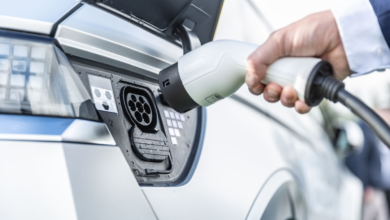Legacy automakers struggle with EV transition, hybrids offer profitability amid uncertainty

Welcome back to the latest episode of the Future of Automotive on CBT News, where we put recent automotive and mobility news into the context of the broader themes impacting the industry.
I’m Steve Greenfield from Automotive Ventures, and I’m glad that you could join us.
The automaker transition from internal combustion to EV drivetrains continues to cause pain for the legacy automakers, but the one bright spot, from both a demand and profitability standpoint are hybrids.
The CEOs of Ford and General Motors recently offered up very different perspectives on the importance of hybrid vehicles to their long-term strategic plans.
Ford CEO Jim Farley wants the industry to stop viewing hybrid vehicles as only an interim solution to be used until drivers are comfortable going fully electric, while GM CEO Mary Barra does not view the technology as a longer-term play.
This week, GM CEO Mary Barra stood firm on the automaker’s strategy to transition to electric vehicles even as some shareholders questioned market demand for the vehicles during GM’s annual shareholder meeting Tuesday.
Barra did say that, ultimately, the composition of GM’s future vehicle lineup will be guided by customer demand. That appeared to be an easing of GM’s previous stance that all of its new vehicles would be all-electric by 2035, but later in the day, a company spokesman said GM stands firm on the 2035 goal.
If you recall, GM announced just last month that their Cadillac brand will likely not have an exclusively all-electric portfolio of vehicles by the end of the decade, which was an earlier target. Instead, it will continue to offer internal combustion engine vehicles.
Ford CEO Jim Farley recently said many of the automaker’s U.S. hybrid models have become more profitable than their gasoline-powered counterparts as interest in the technology grows and demand for electric vehicles lags expectations.
Ford’s U.S. hybrid sales have jumped 47% this year through April, and Farley said one out of every four F-150s sold today is a hybrid. Ford has said each of its North American nameplates will include a hybrid variant by the end of the decade.
Farley said recently that he doesn’t see the technology as simply a stepping stone that will fade as automakers ramp up EV sales, referencing early models such as the Toyota Prius.
What’s Stellantis’ perspective in all of this?
Stellantis CEO Carlos Tavares recently remarked that the transition to electric vehicles will impose a “significant burden” on suppliers, as Western automakers race to cut costs and compete with Chinese peers.
Tavares said the challenge for automakers was to sell EVs, whose production costs are 40 to 50 percent higher than cars with internal combustion powertrains, at the same price as equivalent ICE models. This forces them to cut costs at every level of their operations, including supply chains and logistics.
With legacy automakers spending upwards of a trillion dollars to retool their factories and build new plants to transition from internal combustion drivetrains to EVs and Hybrids, it’s been a huge challenge to be able to anticipate consumer demand.
Even will billions of dollars of consumer-facing government incentives meant to spark demand in EVs, we still see the combination of battery EV and plug-in hybrids only representing about 8% of total new passenger sales. The surprise growth this year has been in the non-plug in hybrid vehicles, demand for which is currently pretty hot.
With automakers losing billions of dollars across their EV divisions, equating to tens of thousands of dollars per vehicle sold, it’s no surprise that they’re not only stepping back from their ambitious EV targets, but also filling in the gap with new Hybrid models, which both satisfy consumer interim demand and generate a lot more profit than a full battery electric vehicle.
And finally, the fact that the presidential election is only 5 months way is casting even more uncertainty about the mid-term demand for EVs. Donald Trump has threatened to dismantle the Inflation Reduction Act and tax incentives for EVs, so there’s a great deal of uncertain how much demand will be remaining without any tax incentives to the consumer.
It continues to be an interesting year for EVs and I’m sure it’s enough to create a lot of anxiety and spirited debate within the board rooms of the legacy automakers.
So, with that, let’s transition to Our Companies to Watch.
Every week we highlight interesting companies in the automotive technology space to keep an eye on. If you read my weekly Intel Report, we showcase a company to watch, and take the opportunity here to share that company with you.
Today, our new company to watch is LucidBots.
LucidBots aims to revolutionize the cleaning industry and turn dull, dirty jobs into efficient, effortless tasks that improve cleanliness and quality of life.
LucidBots has invented a purpose-built cleaning drone to make tough exterior cleaning and spraying jobs a breeze. Their Sherpa Drone takes efficiency, safety, and profitability to the next level.
Their Sherpa Drone product offers up to an 80% cost savings compared to traditional methods renting lifts and other heavy equipment.
The Sherpa Drone claims to be able to clean over 300 square feet a minute.
They claim that users can increase ROI up to 400%, and that most users see a return on their investment after only 2 jobs!
If you’d like to learn more about LucidBot you can check them out at www.lucidbots.com
So that’s it for this week’s Future of Automotive segment.
If you’re an AutoTech entrepreneur working on a solution that helps car dealerships, we want to hear from you. We are actively investing out of our DealerFund.
If you’re interested in joining our Investment Club to make direct investments into AutoTech and Mobility startups, please join. There is no obligation to start seeing our deal flow, and we continue to have attractive investment deals available to our members.
Don’t forget to check out my book, “The Future of Automotive Retail,” which is available on Amazon.com. And keep an eye out for my new book, “The Future of Mobility”, which is almost done, and will be out soon.
Thanks (as always) for your ongoing support and for tuning into CBT News for this week’s Future of Automotive segment. We’ll see you next week!



